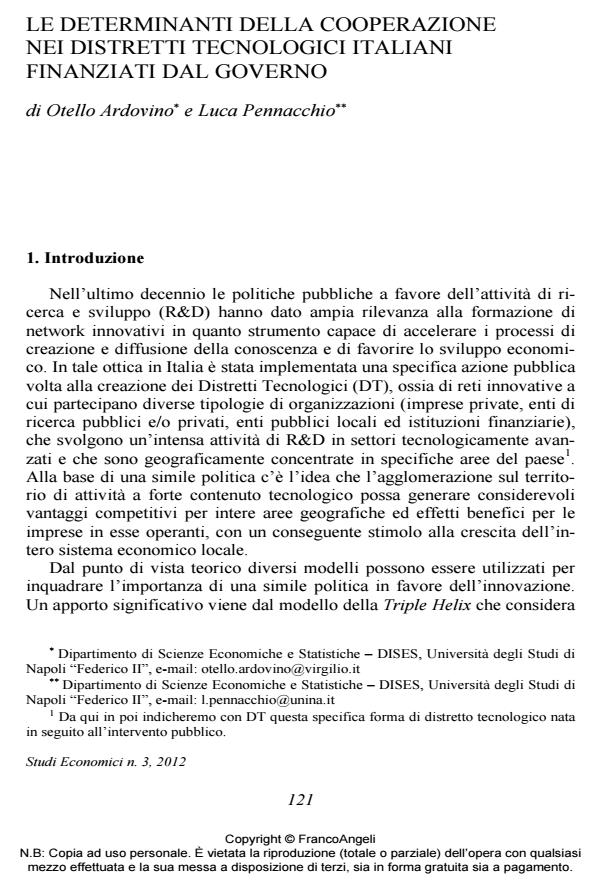Le determinanti della cooperazione nei distretti tecnologici italiani finanziati dal governo
Titolo Rivista STUDI ECONOMICI
Autori/Curatori Otello Ardovino, Luca Pennacchio
Anno di pubblicazione 2013 Fascicolo 2012/108
Lingua Italiano Numero pagine 29 P. 121-149 Dimensione file 946 KB
DOI 10.3280/STE2012-108004
Il DOI è il codice a barre della proprietà intellettuale: per saperne di più
clicca qui
Qui sotto puoi vedere in anteprima la prima pagina di questo articolo.
Se questo articolo ti interessa, lo puoi acquistare (e scaricare in formato pdf) seguendo le facili indicazioni per acquistare il download credit. Acquista Download Credits per scaricare questo Articolo in formato PDF

FrancoAngeli è membro della Publishers International Linking Association, Inc (PILA)associazione indipendente e non profit per facilitare (attraverso i servizi tecnologici implementati da CrossRef.org) l’accesso degli studiosi ai contenuti digitali nelle pubblicazioni professionali e scientifiche
This paper aims to identify the factors that result in cooperation in R&D in high-tech industrial sectors. Our research focused on Italian technological districts created under a specific public policy to promote innovation and regional economic development. The most interesting results concern the effect of the structural characteristics of the individual districts upon collaboration choices: the probability of cooperating is higher in districts in which universities and public research centres have a major weight and in districts with governance more geared to market logic. Network effects, captured with key indicators typical of social network analysis, also play an important role in causing the propensity to cooperate. Our findings confirm the importance of factors identified by the traditional’literature and which may be chiefly ascribed to the transfer and absorption of knowledge. However, the latter would appear to have less impact on collaboration strategies than specific district factors and network effects.
Parole chiave:R&D cooperation, technological districts, applied econometrics, firm behaviour, innovation policy, knowledge spillovers.
Jel codes:C35, D22, L14, O31, O32
- Knowledge and Networks Laura Prota, Maria Prosperina Vitale, Maria Rosaria D’Esposito, pp.169 (ISBN:978-3-319-45022-3)
- La collaborazione nel settore dell'artigianato artistico in Campania: il caso dell'oreficeria Alfredo Del Monte, Alessandro De Iudicibus, Sara Moccia, Luca Pennacchio, in STUDI ECONOMICI 117/2016 pp.77
DOI: 10.3280/STE2015-117005 - Cooperazione in ricerca e sviluppo e attività innovativa delle imprese: un'analisi empirica della realtà italiana Otello Ardovino, Luca Pennacchio, Giuseppe Piroli, in STUDI ECONOMICI 109/2014 pp.68
DOI: 10.3280/STE2013-109004
Otello Ardovino, Luca Pennacchio, Le determinanti della cooperazione nei distretti tecnologici italiani finanziati dal governo in "STUDI ECONOMICI " 108/2012, pp 121-149, DOI: 10.3280/STE2012-108004